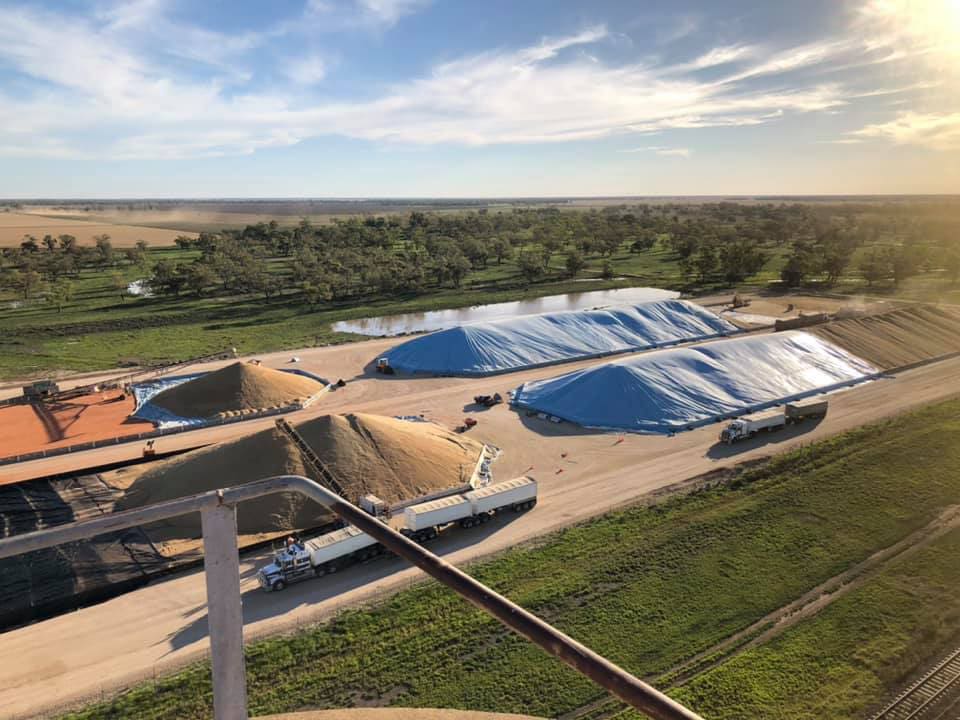
Burren Junction is one of the sites in north-west NSW to be receiving big tonnages now that harvest is in full swing. Photo: Kellie Weise, GrainCorp
AS THE saying goes “timing is everything”, and the rumours last week that China was about to add wheat to its ever-increasing list of banned Australia imports could not have come at a worse time for Australian grain growers. Just as the enormous Australian winter-crop harvest moves into top gear and grain growers look for some harvest cash flow, buyers ran for cover to assess the impact of the potential ban, and prices fell accordingly.
Queensland wheat values were the hardest hit, with port bids for the benchmark grade of Australian Premium White (APW1) tumbling more than $40 per tonne by week’s end. The impact on the lower protein grades such as Australian Standard White (ASW1) and the minimum stockfeed wheat grade generally acceptable for livestock rations, SFW1, was not as dramatic. However, they still fell $20/t and $25/t respectively.
Price declines in New South Wales were less, with APW1 down by around $25/t in the Newcastle zone in the north, and $15/t in the Port Kembla zone in the south. The fall in ASW1 values was greater in the south at $20/t, around double the decrease in the north.
Winter-crop production in NSW is set for a massive turnaround compared to the past couple of drought-devastated years. Wheat will be a bin-buster, with forecasts in excess of a record 13 million tonnes (Mt) now common, 3Mt more than what the state produced in 2016-17. This is already putting pressure on the state’s storage-and-handling system. There are reports in north-west NSW
of sites filling up, and harvest is less than 75-per-cent completed. Growers are delivering grain quicker than it can be railed out to port, and the grower is a willing seller, despite the fall in values.
Wheat bids in Victoria fell by around $20/t across the board, and in South Australia it was a little higher at $23/t. Western Australian values fell by only $15/t across all of the major grades last week, making it the most expensive wheat in the country, quite a rare occurrence considering the state’s eternal export focus.
Cheaper than Black Sea
The fall in prices relative to global values has been so dramatic that, for the first time since 2016, the cost of Australian wheat delivered into key South-east Asian destinations is now lower than that of Black Sea origin. Late last week, APW was reportedly being quoted at US$275/t cost and freight (c and f) for January shipment, compared to similar quality wheat out of the Black Sea region at $285/t c and f.
China in perspective
China is Australia’s biggest trading partner, and accounted for more than one-third of the nation’s export income in 2019. The imposition of a ban or some sort of trade restriction would represent a further escalation of trade tensions between the two countries. If confirmed, wheat would join a list that already contains barley, sugar, coal, copper ore and concentrates, beef, timber, red wine and lobster.
There was a hint back in September that such action may be imminent when Chinese customs officials stated that they would be increasing testing on Australian shipments, with a focus on insect pests, after some issues with barley imports. The news of the likely ban was apparently delivered with a strong warning that Australian shipments would also be rejected if Chinese importers tried to bypass the restrictions by rerouting wheat cargoes via a third country.
However, the impact of a Beijing ban on Australian wheat imports to China needs to be kept in perspective. China’s importance as a destination for Australian wheat is not nearly as great as that of barley. Prior to the imposition of the barley tariff in May, China accounted for an average of more than 60pc of exports over the past five years. Over the same period, shipments of wheat to China only exceeded 10pc of total exports on one occasion, and that was last season, where national production was one of the lowest on record. Export data for the 2019-20 season reveals that China imported around 1.4Mt of Australian wheat, or about 20pc of total exports. But this was up from 200,000t, or less than 3pc of total exports the previous season.
Probably the best year with which to make a meaningful comparison would be the record production year of 2016-17. Shipments to China in that season were just under 2Mt, or around 9pc of total wheat exports. That number is in line with many forecasts for exports to China in the 2020-21 season prior to the talk of a ban. With one of Australia’s biggest ever wheat harvests well under way, the nation’s exportable surplus is now forecast to be north of 23Mt, and exports could be as high as 20Mt. That means that around 10pc of this year’s wheat export program is potentially looking for a new home.
Renewed relationships
With Australian values so competitive into Asia, and even further afield into regions such as the Middle East and Africa, the task has been made a little easier. A big part of it will be renewing relationships with traditional customers who have been shopping elsewhere over the past few years when Australia had a run of poor seasons. In fact, it is highly likely that many of those traditional Asian consumers will be actively seeking offers of Australian wheat on account of superior quality relative to other origins.
The biggest question is: What happens to domestic prices? Being competitive into the export market suggests downside should be minimal. However, we are not close to the peak of harvest, and the price pressure has only just begun. The trade and consumer will be buyers, but I doubt they will have the appetite to buy the entire crop at harvest.

HAVE YOUR SAY